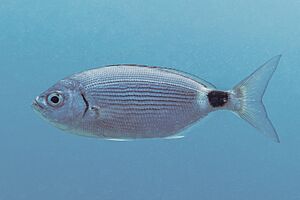Saddled seabream facts for kids
Quick facts for kids Saddled seabream |
|
|---|---|
 |
|
| Conservation status | |
| Scientific classification | |
| Synonyms | |
|
The saddled seabream (Oblada melanura) is a cool fish that lives in the ocean. It's also known as the saddle bream or oblade. This fish is part of the Sparidae family, which includes other seabreams and porgies. It's the only type of fish in its special group called Oblada. You can find the saddled seabream in the Eastern Atlantic Ocean and the Mediterranean Sea. People often catch and eat this fish because it's a good source of food.
Contents
About the Saddled Seabream
What's in a Name?
The saddled seabream has a scientific name, Oblada melanura. The first part, Oblada, comes from an old local name for this fish in Marseille, France. People there used to call it oblado.
The second part, melanurus, is a Greek word. It means "black tail". This name fits perfectly because the fish has a big black spot on its tail area. It looks like a saddle!
How It Looks
The saddled seabream has a body shape that is a bit long and flat from side to side. Its head is straight on top, and it has a pointy snout. Its mouth is low down and has thick lips. The eyes are small.
This fish has small teeth in the front of its mouth. It also has rows of grinding teeth, called molars, in both its upper and lower jaws.
The saddled seabream has two main fins on its back and belly. The top fin (dorsal fin) has 11 or 12 strong spines and 11 or 12 soft rays. The bottom fin (anal fin) has 3 spines and 10 or 11 soft rays.
Its body is mostly grey with shiny silver parts. The back is darker. You can see about 14 or 15 dark brown or grey stripes going up and down its sides. The most special mark is a large black spot on its tail, which has a white edge. This spot looks like a saddle, giving the fish its name!
The fins on its back and tail are light yellow or pink. The other fins are dark. A saddled seabream can grow up to about 36.6 centimeters (about 14 inches) long. But most of them are around 20 centimeters (about 8 inches). The heaviest ones can weigh about 525 grams (a little over a pound).
Where It Lives
You can find the saddled seabream in the eastern part of the Atlantic Ocean. It lives from the Bay of Biscay down to Angola. It also lives in the Mediterranean Sea, the Sea of Marmara, and the southern part of the Black Sea.
This fish likes to live in water that is not too deep, usually up to 30 meters (about 100 feet). It prefers places with rocks or areas with seagrass beds, like Zostera seagrass, and seaweed.
Life and Habits
Saddled seabreams like to hang out in groups. They are social fish! They lay their eggs, a process called spawning, in June and July. Young fish settle down in their new homes between July and September.
These fish eat a variety of foods, so they are called omnivores. But they mostly munch on small invertebrates, which are tiny creatures without backbones.
Most saddled seabreams are born as one gender and stay that way. However, some can change from female to male as they get older. All saddled seabreams that are longer than 29.3 centimeters (about 11.5 inches) are female.
Sometimes, these fish can be curious about people swimming in the water.
Fishing for Saddled Seabream
The saddled seabream is an important fish for food, especially in the Mediterranean Sea. In 2005, about 862 tonnes (that's a lot of fish!) were caught there.
Both commercial fishermen and people who fish for fun catch this species. But it's not usually the main fish they are trying to catch. They use different ways to catch them, like big nets that are pulled along the beach (beach seines), or nets pulled by boats (trawls), and even simple hand lines.
You can often find saddled seabream for sale in fish markets in the northern Mediterranean. However, it's not as common to see them for sale in places like North Africa, Israel, or France. Sometimes, fishermen in Portugal even throw them back into the sea.
When caught, the fish are sold fresh or frozen. Even though their meat is not considered the best, they are still used for food. They can also be turned into fish meal or fish oil.


